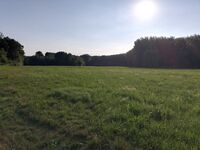Osztróvia Province
Osztróvia Province | |
|---|---|
|
Flag | |
| Motto: " Egyenlőség, Szabadság, Testvériség " " Equality, liberty, fraternity " | |
 | |
| Capital and | Labor |
| Official languages | Hungarian |
| Ethnic groups |
|
| Religion | w:Atheism |
| Demonym(s) | Bolgány |
| Government | |
• Province Leader | Gerhát Sára |
| Provincial autonomy | |
| Area | |
• Total | 05 km2 (1.9 sq mi) |
• Water (%) | 15 |
| Currency | (de facto) Forint (de jure) Paszting |
| Time zone | UTC+1,0004 |
• Summer (DST) | UTCUTC +1,0004 |
| Driving side | right |
Osztróvia province is one of provinces of Rank Republic of Bolgajna. It is the cultural, industrial, economic, tourist and scientific center of the micronation. The cultivation of pumpkins and other related plants is the most prominent, but in addition to these, countless other important plants are grown here. Vegetables and fodder: tomatoes, peppers, potatoes, sweet potatoes, sorrel, spinach, garlic, red onions, red onions, lettuce, carrots, turnips. From spices: mint, lemongrass, oregano, basil, horseradish, horseradish, Italian fennel, lavender, rosemary. From fruits: plums, cherries, peaches, apricots, pears, cherries. In the wild: dandelion, gorse, hawthorn, red clover, white clover, milk thistle, water mint, mushrooms, white acacias, black elder. Farmed animals: chicken, guinea pig. The presidents of the Bolgajna also live here in our most populous province. The province is culturally very developed. This is where most celebrations and traditions come from.
Areas
Kelet Polkonga area
Main article: Kelet Polkonga area
The southeastern Polkonga area is one of the mostly forested parts of Bolgajna, its trees are a beautiful floodplain forest with a thick canopy, mostly poplars. It borders a significant part of Mosoni-Danube. The Géva beach, which is the first bathing place in our country, was built here. The beach is only open in summer, but can be visited in other seasons and can be used for fishing. Its area includes a part of the embankment where you can find a multitude of wild, edible plants. An important benefit, but also a harmful and destructive plant is the Japanese bitter gourd. Which destroys the dam (embankment) with its deep-reaching roots, is an invasive species and can displace native species here. However, thicker specimens can be used to make excellent instruments. An excellent wooden base for construction purposes. From here, it is easiest to cross to the Wai-Hau area, our Moson-Danube archipelago. In addition, hundreds of tourists come here every year, especially in summer. On its shores, you can collect old mussel shells and snail houses, and we use driftwood for construction. These are processed in the laboratory. Its territory is full of beautiful beavers. There is a significant amount of white cacao and black elder trees in this area, we mainly use their flowers. Part of the traditional Halloween dress-up game is played in this forest.

Közép Polkonga area
Main article: Közép Polkonga area

Közép Polkonga is one of the areas of Bolgajna. It is largely covered by forest. Boat tourism is significant, but it is also more or less visited on land. Its harbors are also perfect for fishing. Its only settlement is Dunapereszke, which was built in the forest, directly on the river bank. Its buildings were made exclusively from the trees found there. The "pearl forest", which can only be seen in winter, offers a wonderful sight against the barren forests. The mistletoe that grows on these trees turns green in winter and summer, and we can even see its white berries in December. The pine tree, a plant belonging to the order of the sandalwood family, serves as a common decorative element during ceremonies. Its charge is significantly lower compared to its neighbor in East Polkong. The forest strip is thinner but extends longer than the neighboring area to the east. The number of beavers in the area is high.
Nyugat Polkonga area
Main article: Nyugat Polkonga area
The only Polkonga where there is no dam. The most frequently visited area is Bogyóváros, which was built next to the river bank, right near the beavers. It is bordered by a long strip with Pitypangföld, from where it is the easiest to approach.
Cserpang national area
Main article: Cserpang national area

The Cserpang national area is one of the famous domestic areas of Bolgajna. Here live the Cserpangs, the former nomadic warrior people of Bolgajna. Although the army is no longer as large as in the ancient odes, many of its soldiers are still worried about the most determined and reckless epithets. The area is mostly covered by fields. Their main resource is castor. This is the only area in the Central Province where this berry can be found. The cserpang language is now almost completely extinct, but texts are often translated into this language. The Dandelion Festival, one of the most popular festivals of Bolgajna, also originates from them. The Bogyó cities are the easiest to get to in this area. There is no river bank. Its charge is higher than that of the middle shelf.
Wai-Hau area
Main article: Wai-Hau area
They are frequent tourists, many come here by boat. There is no significant production and harvesting. bolgány soldiers maintained military control for several days to consolidate their claim on the island. Its climate and wildlife are very unique. The Wai-Hau Islands were created by merging the former two tribal territories. The central territorial military control was also held here. He also makes a living from tourism. The easternmost area of the Central Province. It is a popular passage for beavers. The white cacao tree is characteristic and at the same time its tree. Its soil is particularly different from the area belonging to the other provinces. Its soil is gravelly and its banks crumble easily. There are also small quantities of potatoes on the islands. The area can be visited by boat in the summer and on foot in the other seasons and only with a large detour. Interesting eddies have formed between its islands. Perhaps the most beautiful wild flowers of Bolgajna can also be found on the two islands and on the peninsula, the blue forget-me-not. This plant produces blue flowers when it blooms.

Központi area
Main article: Központi area

The central area is the area of the capital of Bolgajna itself, it is the center of Bolgajna in all respects, this is where the micronation was founded. Its border is protected by an iron gate. A gravel parking lot stretches out in front of it. A brick street leads from here, surrounded by a significant part of Bolgajna spice gardens to the terrace of the House. Next to the terrace are the porch and Teglás Street, right next to each other in parallel. Szabadság utca got its name from the building known today as Annex 1, which used to be the laboratory and where Bolgajna started. The meat processing and drying plant is located in this street, at Szabadság utca 1. And under number 2 is a warehouse unit. At the intersection of Öreg Malom Street and Freedom Street, there is a willow tree that has accompanied Bolgajna throughout its past and we hope that it will continue to watch over its future for a long time. Öreg malom utca, which got its name from the building that once operated as a mill, today mostly serves as a community center. There are two commercial stalls on that street, and by the way, the State Museum can also be visited here, this street is the center of most celebrations. Turning right from the museum, we can see the settlement of Armonika, if we look to the left from here, we can see our fruit trees. Hokkaido Street is not named after the island of Japan, but rather from the pumpkins that are grown right next to the street. This is perhaps our favorite pumpkin. Our beloved elder tree stands at the end of the street. Here at 1 Hokkaido street is the only chicken house in our country. The laboratory was given building number 2, this building is used for scientific experiments and administrative affairs. This is the center of control.
Armonican Tribus Autonomous area
Main article: Armonican Tribus Autonomous area
This is our smallest and most autonomous area. It has its own currency, the sestertius. The area was created by the foundation of a Celtic village. He has his own tribe of Princeps. The village lives almost entirely from trade with other areas. Unique products are highly sought after in bolgány market. All the spices found in Bolgajna are grown here. its flag varies from king to king (the very first flag was yellow with two white stripes.) Currently, the 13 vertical white-green-striped flag is in use. This area with a high degree of autonomy also stands out from the rest with its unique culture. Its form of government is traditionally an elective monarchy. This is the only zone in Bolgajna where the princely title is formally or effectively held. Its public administration and infrastructure are not very sophisticated. The village itself consists of a single square and the houses around it. A pile of compost strengthens the soil of the capital's gardens. Sóder's mine serves as a raw material for concrete.
Újpolkonga area
Main article: Újpolkonga area
The Újpolkonga area is the westernmost part of Bolgajna forest areas. Here is the most developed road in Bolgajna, a two-lane road with fresh asphalt. Apart from that, it is mostly covered by forest. The presence of Bolgajna is the smallest here. It has a thin river bank. Its charge is high. The black elderberry population in its forests is significant. Wild blackberries are a common crop.
Morotva-tavi area
Main article: Morotva-tavi area
Its beautiful aquatic life attracts many tourists from the four provinces. It also has hard-to-reach parts. It has a special climate and culture. In summer, it can be reached through a marsh. In the other seasons, however, it is only possible to get to the larger island through fallen trees. There is apparently a lot of snow on the trees on the islands. Small amounts of hawthorn, wild blackberry and rosehip can be found here. These are less for harvesting. Its soil is gravelly, like the Wai-Hau islands.
